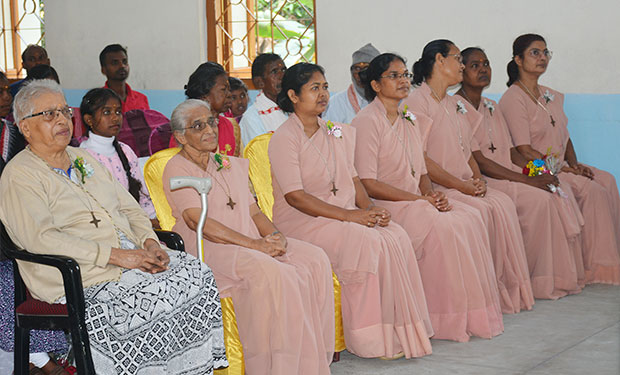|
|
|
Towards renewal and vitality for the RNDMs, Post-Vatican II
From the years immediately following Vatican II until the early eighties, religious life in The move to a post Vatican II religious life constituted a culture shock for some. The structures that had given meaning to their way of life, and given them their particular identity, were being attacked. The Indian province, as part of an international Congregation, struggled beneath the weight a strong western inheritance. It was challenging to therefore change the orientation on mission and to let go of western style of living and dressing to become part of Indian culture and the Indian people. It was a great transition, involving much risk and letting go. The RNDMs in The special RNDM chapter of 1969 introduced the Prayer of the Church “the Divine Office” in English. The Morning and Evening prayer took place in the community and mid-day and night prayer privately. Daily recitation of many vocal prayers was reduced and was not compulsory. Devotion to the Trinity grew in importance. Sisters were encouraged to be creative in the preparation of liturgical celebrations. Sr. M. Bernardine Mullaveetil, then Provincial at this time, took a vital role in introducing inculturation, and initiating the recommendations of the General Chapter in 1984. The sisters were sent to study Indian Spirituality. They attended short courses and experienced Ashram life. Ashrams are an integral element of the spiritual heritage of The sisters followed the Indian way. Indian architecture was appreciated, presenting Biblical stories through Indian dance and music, meaningful adaptation and inculturation in liturgy. Oil lamps replaced candles. External signs of inculturation included use of incense sticks, arati, Bhajans, praying squatted on the floor, use of mats, and use of vernacular rituals and customs. Indian dress- the sari and churidar, and typical Indian food - use of spices, and used fingers for eating, were accepted and adopted. The sisters were invited to use the Holy Scriptures and Sacred writings of other religions and cultures of The concept of Trinity, where God is understood as mother and father, became a central component of a revised Sprituality. We were awakened to Creation spirituality which is embedded in our land. We learn about environment and ecological issues, deepening the art of loving and revering all the living things and creation as a whole. We engage in a dialogue of life, with cultures, traditions and religions to encounter the God who is all in all. The sisters discovered that in the Indian context the RNDM Charism offered perspectives of a holistic spirituality, which has three constituents; the contemplative perception of the divine presence in the universe is dhāyān marga, a total communion in devotion to the divine Lord and to the people in love is called bhakti marga and participation in the work of the Divine Spirit in the universe is karma marga. A pattern of dhāyān-bhakti-karma contemplation, communion and mission offers a theological paradigm for an integral Christian spirituality to Indians. [3] Adding to the traditional ministry, we have entered in to partnership with Bishops and Jesuits priests, and other Religious Congregations, Governmental and Non-Governmental Organizations mainly focusing on formal and non-formal education, empowerment of women and marginalised groups who are being ill-treated by the powerful. We practice freedom, lenient consideration, and personal and community evaluation. The plurality of religions, cultures, languages and mindsets in General chapter 2008 “RNDM Earth community, we are one, we are love” was a clarion call to all the sisters in the province to commit themselves to take responsibility for caring for the Earth and to experience our interconnectedness with whole of Cosmos. |
|

